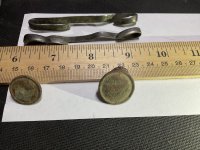LM
Hero Member
I don't understand anything about the theory involved with these machines, so please forgive the ignorance.
http://www.jeohunter.eu/jeosonar.htm
Could that be modified with an extended cable, allowing the head to be hand-operated underwater by a diver in a relatively shallow saltwater environment, the data then transmitted back to the systems computer on the boat? I'm assuming that waterproofing the head and submerged connections wouldn't pose any unique challenges and obviously, the computer would be kept dry.
http://www.jeohunter.eu/jeosonar.htm
Could that be modified with an extended cable, allowing the head to be hand-operated underwater by a diver in a relatively shallow saltwater environment, the data then transmitted back to the systems computer on the boat? I'm assuming that waterproofing the head and submerged connections wouldn't pose any unique challenges and obviously, the computer would be kept dry.





